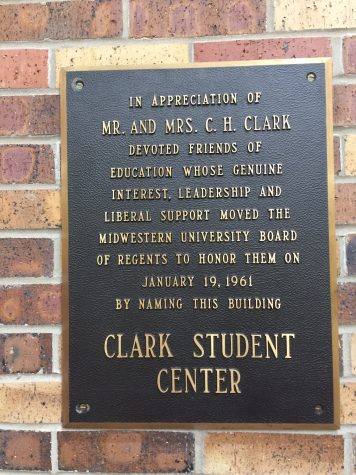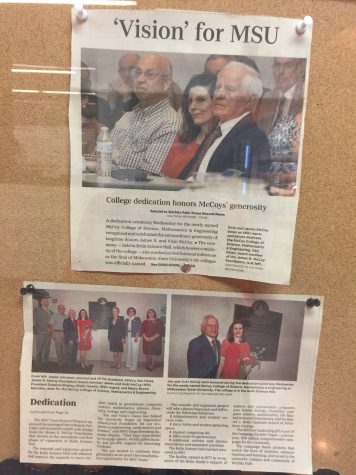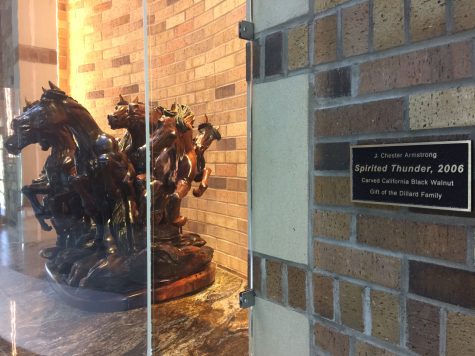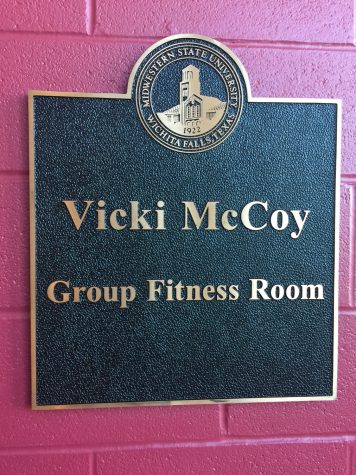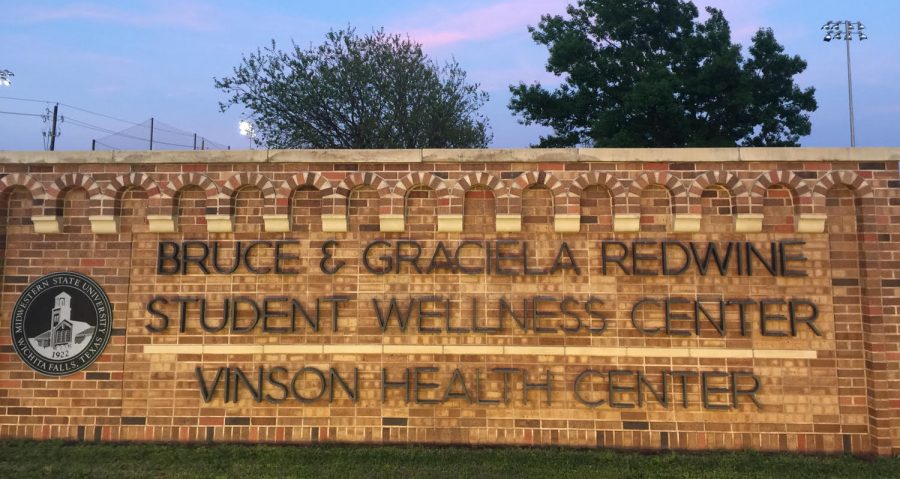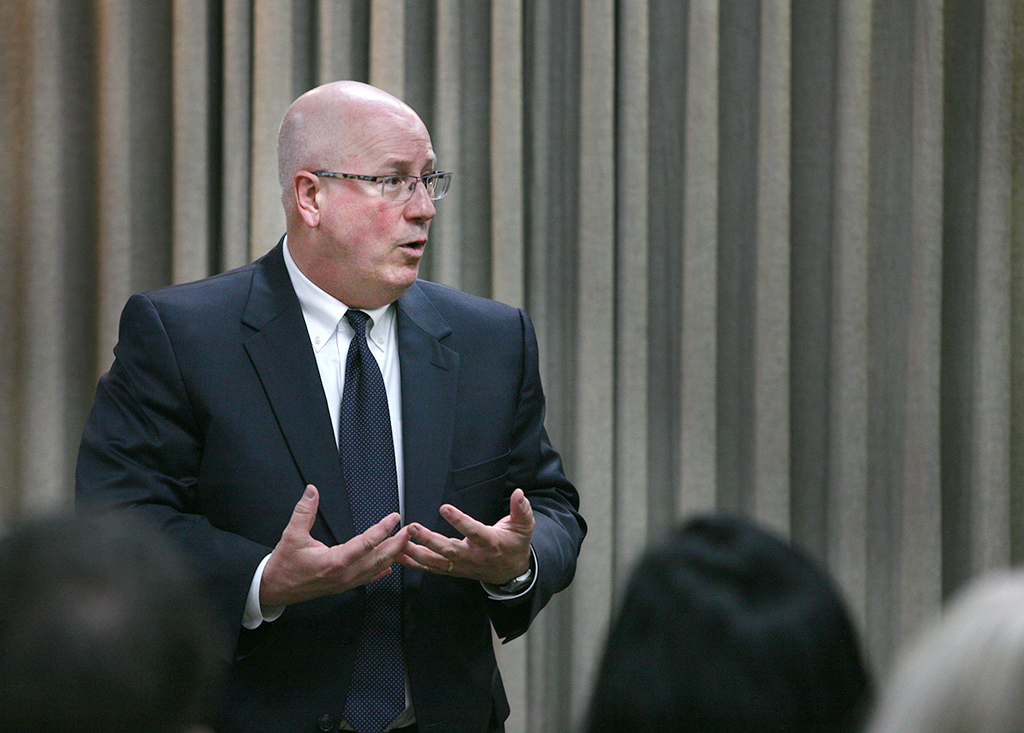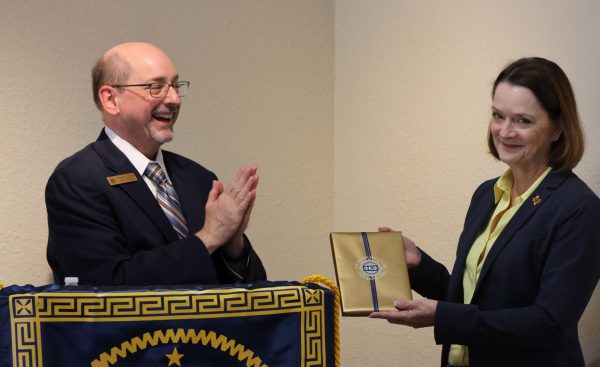Buildings begin with donors
Because of their $12 milion donation, the student wellness center was named after Bruce and Graciela Redwine. Photo by Elizabeth Mahan
Every day, without a second thought, students pass by building dedication plaques on their way to class. Although student often overlook them, these historical pieces provide only a glimpse into the unique story of donations behind the name of each building on campus.
Tony Vidmar, vice president of university advancement and public affairs, said he enjoys connecting donors to the university.
“That’s one of the things I love about being a fundraiser. I’ll never be able to give $1 million to anything, but I can help, and I have helped connect donors to the university in a way that’s meaningful to them and all of the students. That’s why our team that works in advancement loves to do it,” Vidmar said. “It’s really fun to take a need that a university has and connect them to a donor. It’s meaningful to the donor. It’s meaningful to the university, and it helps the students. It’s a win win win. That’s ultimately what you’re trying to do with naming.”
Vidmar mentioned that certain policies are in place to help specify the criteria necessary for a donor to have something named after them. Part of Policy 4.146: Honorific and Gift Related Namings, which the Board of Regents approved on Nov. 10, 2017, states that the president of the university and the Board of Regents must approve all honorific namings. The Board bases their decision on not only the amount gifted by the donors but the donor’s relationship with the university.
Vidmar said, “It’s not just the money. You can’t just buy your way into it. You have to be upstanding people on top of that. With the Dillard family, they’ve had such an impact on Wichita Falls that people know them. If you grew up in Wichita Falls, you would have known the Dillard name.”
Julie Gaynor, marketing and public information director, agreed that donors give more than just their money to the university.
“A lot of these donors are deeply rooted within our community, so they have invested an interest in us. They love the students. They’re just invested in us. They appreciate our mission. If they didn’t, we wouldn’t be seeing them invest their time, treasure, and talent to those programs,” Gaynor said.
Vidmar also referenced what he called the three T’s: time, treasure, and talent because donors are often involved in multiple aspects of the university.
“They may be on advisory boards. They may help out at the art museum. They may be involved with athletics, and they typically are advocates for MSU, not just the money,” Vidmar said. “It varies per person. A lot of our donors serve on our boards and help us govern. Others will be involved in athletics and in the arts.”
Vidmar said some donors donate anonymously, while others want their name attached to it. Donors often name buildings after themselves, but sometimes they choose to honor a family member or someone else meaningful to them. Whatever name the donor chooses to use must represent an honorable citizen.
“The Dillards, the McCoys, these are not just people with money. These are people of great integrity and great commitment to their community. We won’t take money from just anyone off the street. It must be approved,” Vidmar said.
Vidmar said many donors such as the McCoys and the Dillards continue to give to the university even after their big multi-year pledges, although they might not be giving at the same level.
Vidmar said, “Many of them keep giving because the really care. Often times these people have made provisions in their wills for Midwestern State. Even when they pass away, many of these people are giving to MSU. We’ll see scholarships that we don’t even know are going to be available until the person passes away because they want to be anonymous, so they put it in their will.”
Even those who donate small sums don’t go unnoticed by Vidmar. He said he writes a thank you letter to everyone who donates to the university, whether it’s $5 or $5 million.
“There’s a lot of donors that their names aren’t on the building, but they’re still important, and they love this place too. Some people may only be able to give $25, but it means a lot to them,” Vidmar said. “When I saw donations come in last year at $20.18 I knew those were from a senior that was graduating. That $20 is a lot of money coming from a college senior.”
HISTORY
Vidmar mentioned that fundraising also has an element of history, which is a topic that Cortny Bates, special collections librarian and associate university librarian, learned about while documenting MSU’s history in a series of slideshows that are now on the Moffett Library website.
Bates said, “We used to have framed pictures of newspaper clippings all along the walls of the library, and at some point in the early 2000’s, they decided to stop doing that. I just wanted to find a way to make the information more current and more accessible, so we came up with the idea to do the digital display.”
Bates said she spent the year of 2015 working on the slideshows, and in February 2016, there was an event to unveil the digital display.
“A lot of older people that went to school here come in, and they love to look through it just for nostalgia. I also think it’s important for current students to feel more invested in being a student here, to know the history, and know how long we’ve been here and what we’ve been through,” Bates said.
THE BRICK
Part of MSU’s history, the brick that covers the exterior of the buildings used to be a highly sought after aesthetic.
Vidmar said, “In the old days with the old buildings, the Midwestern brick was so important to the people of Midwestern State University that they told donors ‘If you could pay for bricking the building, we’ll name it after you.’ That’s how some of those older buildings were named back then like Fain Hall.”
Both Gaynor and Vidmar referenced The Better Part of a Century by Everett W. Kindig as a source for their knowledge of building naming.
On page 183, Kindig wrote, “A plain exterior would have cost less, but Jerry Vinson [a founder of the Wichitan] and Ralph Harvey [former board trustee] insisted MU’s brick and Spanish Renaissance style continue. Once the $795,000 appropriation was in hand, trustees signed a contract. Ground breaking occurred in a drizzling rain, early in January of 1963.”
After the only supplier of the original brick stopped making it, university officials resorted to brick that resembles the original brick.
Hardin Administration Building
Vidmar said, “Mr. and Mrs. Hardin gave the original money to start the university. It used to be called Hardin Junior college.”
Information about the first building of the university can be found in the first yearbook published by Wichita Falls Junior College, The Wai-kun.
An excerpt from 1935 reads, “We who love it have long cherished the hope that someday our junior college would occupy a building of its own and so have an opportunity to grow into the large institution of which its founders dreamed. During the past year, the action of Mr. and Mrs. Hardin of Burkburnett in providing an endowment fund, that of Messrs. W.B. Hamilton and N.H. Martin in giving a building site, and the continued efforts of a group of public-spirited citizens have made it possible for us to begin to plan for the long-hoped-for and independent new-yet-old college.”
McCoy
“We could have written books about the McCoys, very quiet, unassuming people that love the university,” Vidmar said.
Vidmar used the McCoy family as an example of people who give to multiple areas of the university.
“If you ever workout in the Redwine Center, there’s a workout room where they have some classes, that says Vicki McCoy. She’s an advocate for wellness and health. She’s in really good shape. A lot of people don’t know this, but the McCoys are also involved in donating to tennis,” Vidmar said.
In August of 2018, university officials named the McCoy College of Science, Mathematics, and Engineering after James and Vicki McCoy, who had been donating for 31 years. They made a seven-year pledge of $50 million, according to the Times Record News.
“That was based on the McCoy family’s contributions and they had also given a multi-year pledge. It was years of giving and what they had pledged for the upgrades to the building,” Gaynor said.
Dillard
Gaynor said, “Mrs. Dillard has still been very instrumental because there’s the college and the building named after her, and we have the Dillard Energy Management Center. I know she and her family, her daughter also, recently contributed to the establishment of our agribusiness concentration.”
Carol Dillard and Dr. Suzanne Shiply, university president, created the agribusiness concentration about a year and a half ago, for students who wanted to pursue ranching.
“At the time of 2006, the donation to the Dillard building was the single largest gift to the university at the time. It was $5 million,” Vidmar said.
Redwine
Also worth mentioning, the Redwine family has donated a larger sum since then to the Bruce and Graciela Redwine Wellness Center.
Vidmar said, “When you walk into the Bruce and Graciela Redwine center, that family gave over $12 million to the university. A lot of it came from their estate. Mr. Redwine also helped out with making the signs that say Midwestern State University, the gates that people take their pictures with when they graduate.”
Moffett Library
Gaynor looked through records that her predecessors kept in folders to confirm that the naming of the Moffett Library was based on a political connection. The article she read from was published in 1986, at the time of the library’s last remodel. It explained that George Moffett helped change Midwestern University to Midwestern State University.
“Senator George Moffett was instrumental in bringing Midwestern into the Texas state system,” Gaynor said.
According to The Better Part of a Century, Senator George Moffett was present when the library was named after him on May 29, 1964.
